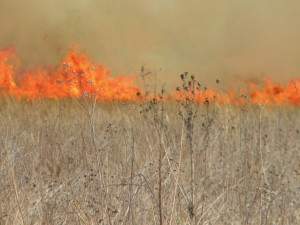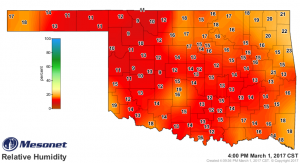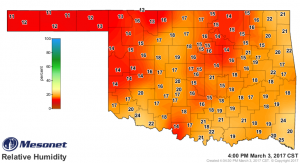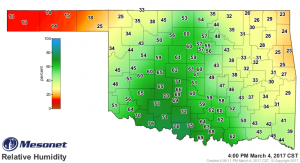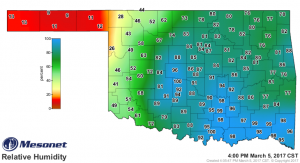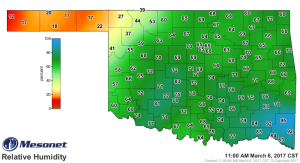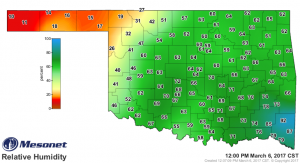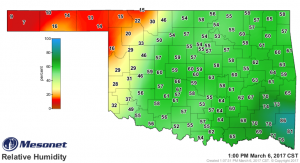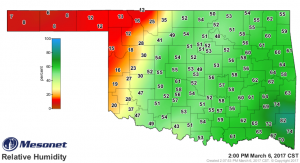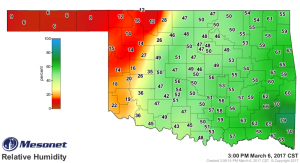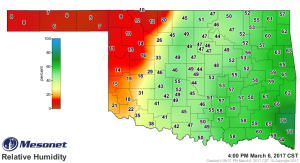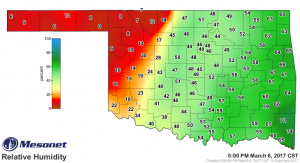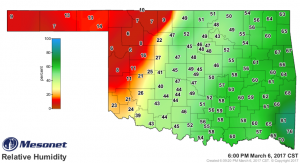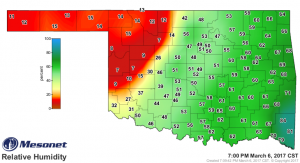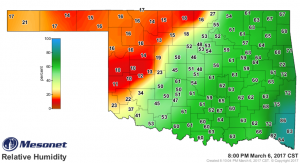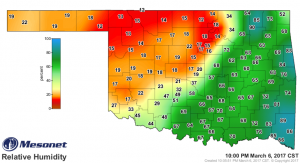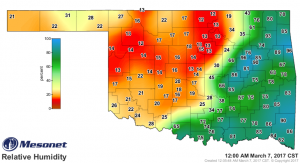As relative humidities drop, standing, dead plant stems dry out. Dense, dead, dry grasses were the primary fuel source for the devastating fires that flared up on March 6, 2017 in Oklahoma, Kansas, and Texas. This article is part two of a three part series. It covers the relative humidity conditions in Oklahoma leading into this horrendous fire day.
March kicked off with relative humidities unusually low across Oklahoma. On Wednesday, March 1, 2017, the highest afternoon humidity was twenty-three percent at the Westville Oklahoma Mesonet site. Relative humidities in the red areas were below fifteen percent. As a reference, it’s good to remember that whenever relative humidities drop below 30% fire risk ratchets up. Add high winds and fire fighters prepare themselves for a bad fire day.
The afternoon of March 2nd was almost a duplicate of March 1st.
Afternoon humidities on March third were a dash higher, but still the highest relative humidity was only twenty-five percent at Idabel in the southeast.
March 4th afternoon humidities were much higher across most of the state, but the Panhandle continued on the dry side, with humidities below twenty-five percent.
On Sunday afternoon, March fifth, blue areas had low colds and rain mists. But out in the Panhandle humidities were just over ten percent. That made it five consecutive afternoons that relative humidities were below twenty percent in the Panhandle.
What would be the largest fire of the Northwest Oklahoma Complex Fires, the Starbuck Fire, ignited between 11:00 AM and noon on March 6, 2017 to the northeast of Beaver, Oklahoma. At 11:00 AM the relative humidity at Beaver was seventeen percent.
As Monday progressed the relative humidities continued to drop in the Panhandle and other parts of western Oklahoma.
At 1:00 PM, the Panhandle had single digit relative humidities at Kenton and Boise City.
Winds shifted from west to the northwest at 4:30 PM at Eva and at 5:00 PM at Beaver. These winds shifted fire movement from northeast to southeast.
Sunset on March 6, 2017 at Beaver, Oklahoma was at 6:41 PM.
At 8:00 PM, no Mesonet site had a single digit relative humidity and Boise City reached 21%.
Dryer air expanded across the state into central and eastern Oklahoma as the night moved on.
The first relative humidity above 30% in the Panhandle, since the Starbuck fire started, was recorded at Goodwell at midnight.
The afternoon of March 7th was another very low humidity day across the entire state. At 4:00 PM, only five Mesonet sites had relative humidities higher than 15%.
On the afternoon of March 8th a small wedge of humidities above 30% were recorded in the southwest part of the state. But that humidity was not enough to keep Wednesday, March 8th from being another Red Flag Fire Warning day.
The Starbuck Fire began in Oklahoma between 11:00 AM and noon on March 6, 2017. It soon crossed into Kansas, where flames raced across the largest number of acres. Additional fires occurred in Oklahoma, Kansas, and Texas. The speed and intensity of those fires tragically caused 6 fatalities, thousands of livestock losses, untold wildlife losses, hundreds of miles of lost fencing, the destruction of at least twenty homes, and an undetermined number of structure losses.
Part 1 explored the weather role February 2017 played in the Northwest Oklahoma Complex Fires. Part 3 looks at Monday’s high wind speeds.
Thanks to all of the fire fighters. Their hard work and tireless efforts brought control to monster fires, saving lives and property. Thanks too for all of the generous donations in so many forms to help folks through one of the toughest group of fires in Oklahoma, Kansas, and Texas history.
